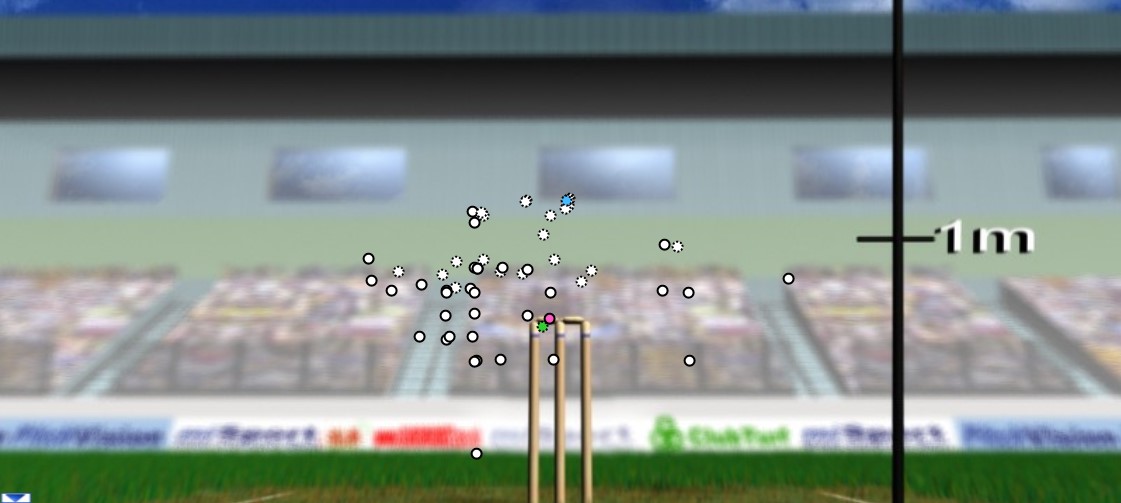 This is a guest article from Waqas Zafar: video analyst, cricket enthusiast and computer scientist based in Lahore. Read more of his work by clicking here. This is a guest article from Waqas Zafar: video analyst, cricket enthusiast and computer scientist based in Lahore. Read more of his work by clicking here.
In this article, I’ll be analysing a seamer from a cricket club who has bowled a total of 368 balls in the indoor nets. The deliveries were tracked on PitchVision's PV/ONE ball tracking over the course of a preseason in the UK.
Here is a breakdown of the lengths he has bowled.
- Short 10.05%
- Good 45.38%
- Full 44.29%
Here is the beehive placement of all the balls.

The system shows that the average length bowled by this bowler is 5.75m. This is generally accepted as a good length for English club cricket. Let’s look into detail about each length.
Short
This bowler hasn’t dug the ball in short as we can see in the breakdown of the lengths. His average pace from this length was 67.82 mph which is quicker than his average, but won't rattle most batsman. The percentages above clearly illustrates that the bowler wants to get the ball up closer to the batsman).
This is a good tactical approach on slower wickets that see plenty of seam and swing. The bouncer is a far less powerful weapon, and the bowler's pace can't overcome the weakness. Good club batsmen are only troubled when the ball passes 75mph and often this number is higher (such as pro cricketers playing club cricket used to 85mph or more).
Good length
This is the length which isn't quite short enough for the horizontal bat shots and not full enough for the drives. Here is the beehive placement of all the balls in the good length.

We can see some of the balls sliding down the leg side. Some of them have deviated down the leg side, may be due to lack of control but there are a number of balls on off stump and outside.
The average deviation from this length is 0.5 degrees. Good length set by this bowler is 8.0m–5.0m. By applying filters on the PitchVision system, we’ll dig down into the details of this length.
Back of a length
34 balls have been recorded in the 8.0 – 7.0 range. The average bounce recorded from this length is 0.94.

There has been variation in bounce in this region. For example, the ball hitting the stumps pitched on 7.6 m from the stumps meanwhile a ball pitching on 7.0 m from the stumps bounced close to 1 m. All these balls bounce quite high and there is movement on offer as well.
This means at back of a length the bowler can take wickets. Batters are on the back foot and looking to play away from their body can be caught.
Or if the batsman leaves these balls on length, then the bowler can push the ball further up. The bowler is recommended to learn to adjust depending on the strengths and weaknesses of the batsman.
Middle good length
This is the 7.0 – 6.0 range. 58 balls have landed in this spot and the average deviation from this length is 0.6 degrees. The bowler has generally looked to keep it outside off and hasn’t attacked the stumps a lot.
When he did attack the stumps, he bowled someone.
The wicket ball was pitched on 6.8 m whereas a ball landing on 6.4 m took off from the surface. Balls outside off stump which have bounced normally can lure the batsman into coming forward and any movement can bring the keeper and slips into play. When the batsman comes forward, it becomes hard for him to adjust to any sort of lateral movement.
Therefore, it's recommended that the bowler works on bowling most stock balls in this length and at or just outside the stumps.
Fuller good length:
This is the 6.0 – 5.0 range. 70 balls have landed here. Average deviation from this zone is 0.5 degrees.

The seamer has kept it outside off but has looked to attack the stumps more. This is hopefully because he has realised that there is uneven bounce.
We can see a lot of balls on top of the stumps in this beehive placement. This is because of the unpredictable bounce, as they have missed the stumps. For example, the wicket ball (pink ball smashing the off stump) pitched on 5.6 m. Another ball pitching on 5.6 m missed the stumps by a fair margin.
It is recommended that the bowler continues to bowl this length and attack the stumps. Most wickets he will bowl on will have 0.2-0.1m lower bounce and the stumps will come into play much more than happens on this bouncier indoor wicket.
Full balls

The bowler has landed 163 balls in the full zone. These are over-pitched balls that the batsman will look to drive or flick. The balls which didn’t deviate were put away but that shouldn’t discourage the bowler as wickets can still fall when you over pitch either with bowled, LBW or catches from mistimed shots.
By breaking down lengths, the bowler can work on specific things like:
- To be able to maintain consistent lines as we can see a lot of balls sliding down the leg side.
- Look to bowl within stumps if there is any unpredictable bounce.
- Not overpitch a lot of times as we can see from the beehive placement.
- Hitting the block hole at the death.
 This is a guest article from Waqas Zafar: video analyst, cricket enthusiast and computer scientist based in Lahore. Read more of his work by clicking here. This is a guest article from Waqas Zafar: video analyst, cricket enthusiast and computer scientist based in Lahore. Read more of his work by clicking here.
In this article, I’ll be analysing a seamer from a cricket club who has bowled a total of 368 balls in the indoor nets. The deliveries were tracked on PitchVision's PV/ONE ball tracking over the course of a preseason in the UK.
Here is a breakdown of the lengths he has bowled.
- Short 10.05%
- Good 45.38%
- Full 44.29%
Here is the beehive placement of all the balls.

The system shows that the average length bowled by this bowler is 5.75m. This is generally accepted as a good length for English club cricket. Let’s look into detail about each length.
Short
This bowler hasn’t dug the ball in short as we can see in the breakdown of the lengths. His average pace from this length was 67.82 mph which is quicker than his average, but won't rattle most batsman. The percentages above clearly illustrates that the bowler wants to get the ball up closer to the batsman).
This is a good tactical approach on slower wickets that see plenty of seam and swing. The bouncer is a far less powerful weapon, and the bowler's pace can't overcome the weakness. Good club batsmen are only troubled when the ball passes 75mph and often this number is higher (such as pro cricketers playing club cricket used to 85mph or more).
Good length
This is the length which isn't quite short enough for the horizontal bat shots and not full enough for the drives. Here is the beehive placement of all the balls in the good length.

We can see some of the balls sliding down the leg side. Some of them have deviated down the leg side, may be due to lack of control but there are a number of balls on off stump and outside.
The average deviation from this length is 0.5 degrees. Good length set by this bowler is 8.0m–5.0m. By applying filters on the PitchVision system, we’ll dig down into the details of this length.
Back of a length
34 balls have been recorded in the 8.0 – 7.0 range. The average bounce recorded from this length is 0.94.

There has been variation in bounce in this region. For example, the ball hitting the stumps pitched on 7.6 m from the stumps meanwhile a ball pitching on 7.0 m from the stumps bounced close to 1 m. All these balls bounce quite high and there is movement on offer as well.
This means at back of a length the bowler can take wickets. Batters are on the back foot and looking to play away from their body can be caught.
Or if the batsman leaves these balls on length, then the bowler can push the ball further up. The bowler is recommended to learn to adjust depending on the strengths and weaknesses of the batsman.
Middle good length
This is the 7.0 – 6.0 range. 58 balls have landed in this spot and the average deviation from this length is 0.6 degrees. The bowler has generally looked to keep it outside off and hasn’t attacked the stumps a lot.
When he did attack the stumps, he bowled someone.
The wicket ball was pitched on 6.8 m whereas a ball landing on 6.4 m took off from the surface. Balls outside off stump which have bounced normally can lure the batsman into coming forward and any movement can bring the keeper and slips into play. When the batsman comes forward, it becomes hard for him to adjust to any sort of lateral movement.
Therefore, it's recommended that the bowler works on bowling most stock balls in this length and at or just outside the stumps.
Fuller good length:
This is the 6.0 – 5.0 range. 70 balls have landed here. Average deviation from this zone is 0.5 degrees.

The seamer has kept it outside off but has looked to attack the stumps more. This is hopefully because he has realised that there is uneven bounce.
We can see a lot of balls on top of the stumps in this beehive placement. This is because of the unpredictable bounce, as they have missed the stumps. For example, the wicket ball (pink ball smashing the off stump) pitched on 5.6 m. Another ball pitching on 5.6 m missed the stumps by a fair margin.
It is recommended that the bowler continues to bowl this length and attack the stumps. Most wickets he will bowl on will have 0.2-0.1m lower bounce and the stumps will come into play much more than happens on this bouncier indoor wicket.
Full balls

The bowler has landed 163 balls in the full zone. These are over-pitched balls that the batsman will look to drive or flick. The balls which didn’t deviate were put away but that shouldn’t discourage the bowler as wickets can still fall when you over pitch either with bowled, LBW or catches from mistimed shots.
By breaking down lengths, the bowler can work on specific things like:
- To be able to maintain consistent lines as we can see a lot of balls sliding down the leg side.
- Look to bowl within stumps if there is any unpredictable bounce.
- Not overpitch a lot of times as we can see from the beehive placement.
- Hitting the block hole at the death.
Discuss this article with other subscribers
|

.jpg)



.jpg)

